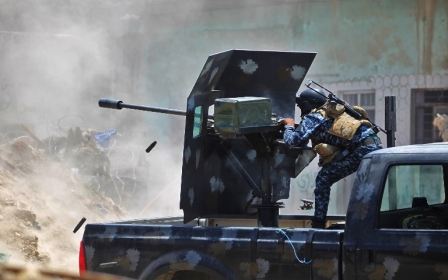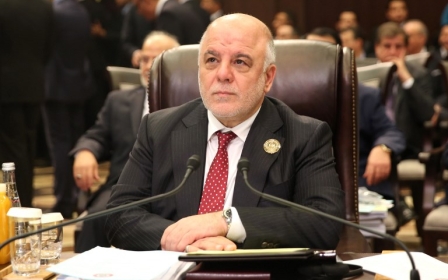IS destroys Mosul mosque where Baghdadi declared 'caliphate'

Iraq on Wednesday blamed the Islamic State group for the destruction of the Grand al-Nuri Mosque of Mosul and its famous leaning al-Hadba minaret, an act described by the prime minister as a "declaration of defeat".
Iraq's prime minister, Haider al-Abadi, called the destruction of the mosque an "official declaration of defeat" by IS.
However, IS swiftly issued a statement via its Amaq propaganda agency blaming a US strike, but the US-led coalition condemned the destruction as a crime against "the people of Mosul and all of Iraq".
"The Daesh (Islamic State) terror gangs committed another historic crime by blowing up the al-Nuri mosque and its historic al-Hadba minaret," the Iraqi military statement said.
The explosions happened as Iraq's elite Counter Terrorism Service units, which have been battling their way through Mosul's Old City, got within 50 metres of the mosque, the statement said.
Iraqi forces earlier on Wednesday said they had started a push towards the mosque. A US-led coalition is providing air and ground support to the Mosul offensive which began in October 2016.
On Tuesday, the forces had encircled the militant group's stronghold in the Old City, the last district under their control in Mosul.
Al-Baghdadi proclaimed himself "caliph", or ruler of all Muslims, from the pulpit of the mosque on 4 July 2014, after the group's fighters overran parts of Iraq and Syria. His black flag had been flying over its leaning minaret since June 2014.
Iraqi officials had privately expressed the hope that the mosque could be captured in time for Eid al-Fitr, the festival marking the end of Ramadan, the Muslim fasting month. The first day of the Eid falls this year on 25 or 26 June.
The fall of Mosul would, in effect, mark the end of the Iraqi half of the "caliphate" which was the largest they had control of in both Iraq and Syria, but IS would continue to control territory west and south of the city.
The mosque's destruction came during the holiest period of the Islamic holy month of Ramadan, its final 10 days.
The night of Laylat al-Qadr falls during this period, marking when Muslims believe the Quran was revealed to prophet Muhammad.
The minaret of al-Hadba has been here forever, it is part of the history of Mosul
- Ahmed Thilij Hamed, Mosul resident
Baghdadi has left the fighting in Mosul to local commanders and is believed to be hiding in the border area between Iraq and Syria, according to US and Iraqi military sources.
IS has destroyed several key heritage sites in Mosul, including the main museum and shrines to Jonah and Seth.
"The minaret of al-Hadba has been here forever, it is part of the history of Mosul, it is the symbol of the city," Ahmed Thilij Hamed, a 49-year-old resident near the Old City, told AFP on Monday.
It had become clear to most in Mosul that IS would not give up its last redoubt in the city without destroying landmarks whose capture by the Iraqi forces would have dealt them a massive symbolic blow.
"When the minaret is destroyed, it will be the final blow to Mosul's heritage because all the other landmarks are gone," Hamed said. "I will be very sorry, I cannot imagine such a moment."
Staff Lieutenant General Abdulwahab al-Saadi, one of the top commanders of the Counter Terrorism Service, said he thought the Nuri mosque and nearby "al-Hadba" would almost inevitably be destroyed.
"The mosque has some symbolism for the terrorist gangs, being the mosque where Baghdadi gave his first sermon" as IS leader, he told AFP on Monday from his command post on the edge of Mosul.
"Daesh might blow up these heritage landmarks for psychological reasons," he said.
"Perhaps they won't want to leave this place that Abu Bakr al-Baghdadi took to the security forces and maybe they'll send a message accusing Iraqi units of of destroying them," he predicted.
The mosque was named after Nuruddin al-Zanki, a noble who fought the early crusaders from a fiefdom that covered territory in modern-day Turkey, Syria and Iraq.
It was built in 1172-73, shortly before his death, and housed an Islamic school.
By the time renowned medieval traveller and scholar Ibn Battuta visited two centuries later, the minaret was leaning. The tilt gave the landmark its popular name: the hunchback.
It was built with seven bands of decorative brickwork in complex geometric patterns also found in Persia and Central Asia.
Nabeel Nouriddin, a historian and archaeologist specialising in Mosul and its Nineveh region, said the minaret had not been renovated since 1970, making it particularly vulnerable to blasts even if it was not directly hit.
New MEE newsletter: Jerusalem Dispatch
Sign up to get the latest insights and analysis on Israel-Palestine, alongside Turkey Unpacked and other MEE newsletters
Middle East Eye delivers independent and unrivalled coverage and analysis of the Middle East, North Africa and beyond. To learn more about republishing this content and the associated fees, please fill out this form. More about MEE can be found here.




